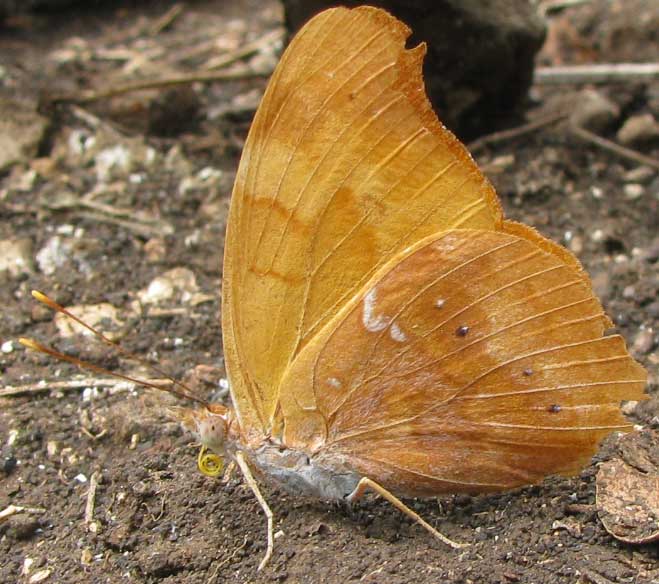Excerpts from Jim Conrad's
Naturalist Newsletter

from the October 31, 2010 Newsletter issued from Hacienda Chichen Resort beside Chichén Itzá Ruins, central Yucatán, MÉXICO; limestone bedrock, elevation ~39m (~128ft), ~N20.676°, ~W88.569°
THE VARIABLE ORANGE BANNER
Throughout September it rained every afternoon, then one day the rain didn't come and since then we've not had a single decent downpour. I've never seen a rainy season end so abruptly. Already the ground is cracking and each day I must water many plants.
After watering, butterflies gather on the moist soil, and I always watch for new species. You can see a bright orange one that landed outside my door above.
I thought it was probably a repeat, the Julia, which also is almost entirely orange with few markings, but I didn't have the Julia's side view so I photographed the visitor, sent the picture to Bea in Ontario, and was surprised when she replied that it something new. It's TEMENIS LAOTHOE, sometimes called the Orange Banner.
Orange Banners are distributed over a very large area, from Texas's southernmost tip all the way south to Bolivia. Within that distribution two distinct color forms are recognized. Ours is the most common, occurring throughout the distribution. However, in Columbia and Peru a small percentage of each brood develops a very striking red and blue coloration.
It's unusual for such a conspicuously different form to arise as "a small percentage of each brood" in a small part of an area of distribution. That isn't how new species generally arise. Really it's not known what's going on here genetically. This is someone's PhD dissertation waiting to happen. You can see how different the red and blue form is at the top of the page here.
The above page also says that the species occurs mainly in primary rainforest and transitional rainforest/ cloudforest habitats in Peru, while ours landed on a barren spot outside my door, surrounded by scrubby, semiarid forest. The species seems to have a good bit of ecological flexibility, too.
The Orange Banner's caterpillars feed on Serjania, Paullinia, Cardiospermum, Urvillea and other shrubs and vines in the family Sapindaceae, all very common here.